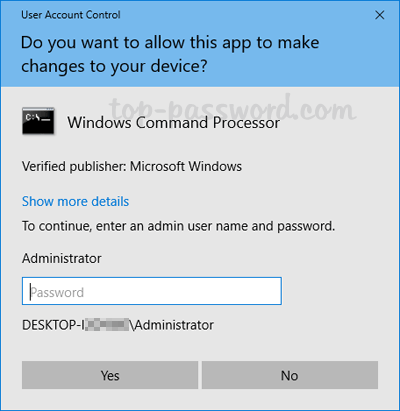
- #Open administrator command prompt windows 10 how to
- #Open administrator command prompt windows 10 windows 10
- #Open administrator command prompt windows 10 password
- #Open administrator command prompt windows 10 Pc
NOTE: On the third command, replace c: with your designated drive (usually large). You must note that you have to hit Enter key after every command. Open a command prompt at the login screen and follow the below commands.
#Open administrator command prompt windows 10 Pc
Restart your PC and start it in BOOT mode (usually, it comes after pressing the F10 key) and once the BOOT window opens, choose the option to boot from the required CD/ DVD or Flash Drive you have inserted.
#Open administrator command prompt windows 10 password
For this, you must have a bootable CD/DVD or flash drive so that you can reset your password using a command prompt.įollow some simple steps and make sure you have inserted a bootable pen drive before following the below steps.
#Open administrator command prompt windows 10 how to
How to Find the Admin Password at the Login ScreenĬmd plays a crucial role when you have locked up on the login screen. But what if you don’t have access to your PC and looking for a command prompt at the startup login screen.Ĭheck out the following method. This means you have already logged in to your PC. This method only works if you have access to your PC. Once done this step, close the command prompt. Check out your admin password and note it. The link won’t do anything or may trigger an error message on other operating systems.3.
#Open administrator command prompt windows 10 windows 10
Users on Windows 10 can click here to open the Settings app directly from their web browser. However, user settings don’t apply at all within recovery mode so it could have been a very confusing experience if you were allowed to open the Settings app. In my opinion, this is kind of a strange decision as the reason you’re in recovery mode may be caused by a setting. Also, note that the Settings app is unavailable from within Windows Recovery mode. These commands - actually the whole ms-settings: URI schema - will not work on older versions of Windows like Windows 8 and 8.1. Or, you can spell it out fully using the PowerShell commandlets (as shown below). You can use the same command in PowerShell - where start is an alias for Start-Process. Step 2: Type the text ‘ cmd’ and click on the Command Prompt icon to launch it. In fact, there are two ways to open Command Prompt in Windows 10. By typing commands at the window, you can perform tasks on your computer without using the Windows graphical interface. A Command Prompt is an entry point for typing computer commands. Step 1: Click on the windows icon from the keyboard. Overview - How to Boot to Command Prompt in Windows 10. The Command Prompt will open in admin mode. Step 2: Press the‘ Ctrl’ key while clicking on ‘Run New Task’. App developers and web authors should take care to link their users directly to the right section in Settings, reducing documentation needs and user friction. Step 1: Open the Task Manager and click on ‘File’. There’s no penalty for guessing wrong, so just take a guess and maybe you’ll drop straight into settings:windowsupdate without using the mouse. For example, ms-settings:network will go directly to the Network and Internet section of the Settings app.

You can optimistically type in an English language keyword after the colon to direct you towards the right section of the Settings app. You’ll still need to use the start program if you want to launch the Settings app from a batch file, however. The Run dialog will recognize the Settings app’s URI scheme ( ms-settings) without passing it through ‘ start’ and start the Settings app accordingly. Omit the start program prefix from the above command if you want to run it from the Run dialog ( Windows key + R) instead of from within a Command Prompt session. You can open the Settings app directly from the Command Prompt ( cmd.exe) in Windows 10 using the following command: start ms-settings: You can open the legacy Windows Control Panel by starting control.exe, but how do you open the Windows Settings app from the Command Prompt or PowerShell?


 0 kommentar(er)
0 kommentar(er)
